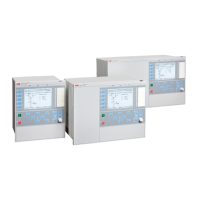current in the neutral of a power transformer. The relay characteristic AngleRCA is
fixed and equals 0 degrees. Care must be taken to ensure that neutral current direction
remains unchanged during all network configurations and faults, and therefore all
transformer configurations/constructions are not suitable for polarization.
In dual polarization, zero sequence voltage polarization and zero sequence current
polarization elements function in an “OR-mode”. Typically when zero sequence
current is high, then zero sequence voltage is low and vice versa. Thus combining a
zero sequence voltage polarized and a zero sequence current polarized (neutral current
polarized) directional element into one element, the IED can benefit from both
elements as the two polarization measurements function in an OR mode
complementing each other. Flexibility is also increased as zero sequence voltage
polarization can be used, if the zero sequence current polarizing source is switched out
of service. When the zero sequence polarizing current exceeds the set value for
startPolCurrLevel, zero sequence current polarizing is used. For values of zero
sequence polarizing current less than the set value for startPolCurrLevel, zero sequence
voltage polarizing is used.
Zero-sequence voltage polarization with zero-sequence current compensation (-
V0Comp) compares the phase angles of zero sequence current I
0
with zero-sequence
voltage added by a phase-shifted portion of zero-sequence current (see equation 234) at
the location of the protection. The factor k = setting K
mag
. This type of polarization in
intended for use in applications where the zero sequence voltage can be too small to be
used as the polarizing quantity, and there is no zero sequence polarizing current
(transformer neutral current) available. The zero sequence voltage is “boosted” by a
portion of the measured line zero sequence current to form the polarizing quantity. This
method requires that a significant difference must exist in the magnitudes of the zero
sequence currents for close-up forward and reverse faults, that is, it is a requirement
that |V0| >> |k · I0| for reverse faults, otherwise there is a risk that reverse faults can be
seen as forward.
AngleRCA
0 0
V k I e- + × ×
EQUATION1638-ANSI V2 EN
(Equation 234)
The negative-sequence voltage polarization with negative-sequence current
compensation (-U2Comp) compares correspondingly I
2
with (see equation
235), and
similarly it must be ensured that |V
2
| >> |k · I
2
| for reverse faults.
AngleRCA
2 2
V k I e- + × ×
EQUATION1639-ANSI V2 EN (Equation 235)
Section 3 1MRK504116-UUS C
IED application
308
Application manual

